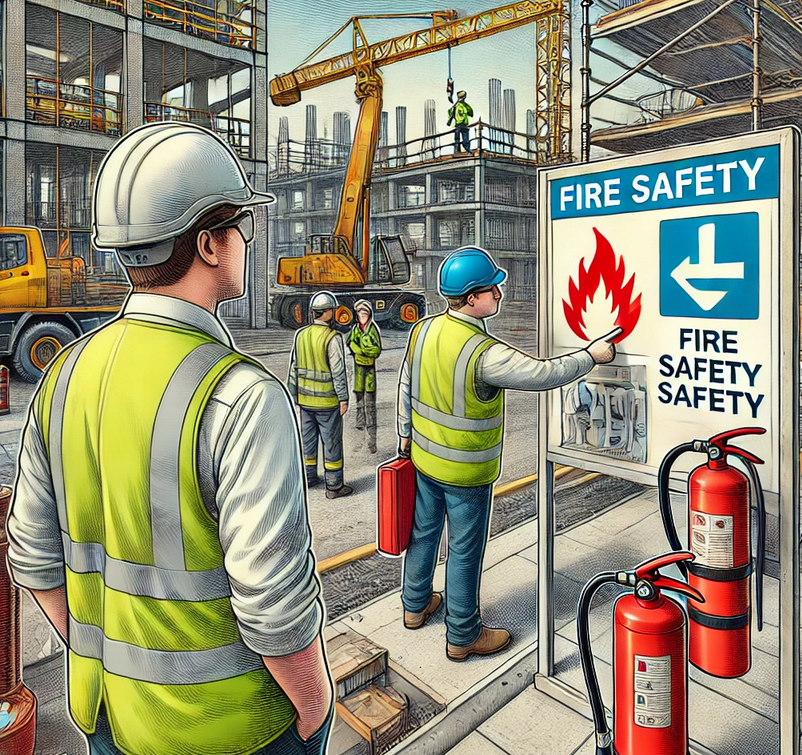Fire Safety in Construction Sites: Key Challenges and Solutions
Construction sites are inherently high-risk environments, and fire hazards are among the most significant threats.
With flammable materials, temporary electrical setups, and heavy machinery in use, it is critical to implement robust fire safety measures.

This article explores key fire hazards in construction sites and offers practical solutions to mitigate risks and ensure worker safety.
Understanding Fire Risks in Construction Sites
Fire hazards in construction sites stem from various sources, including electrical faults, combustible materials, and human error.
Unlike established buildings, construction sites often lack permanent fire suppression systems, making them more vulnerable to fires.
Common Causes of Fires in Construction Sites
- Electrical Malfunctions – Exposed wires, faulty connections, and temporary power supplies increase the risk of electrical fires.
- Flammable Materials – Construction sites contain wood, paint, fuels, insulation, and chemicals that are highly combustible.
- Hot Work Operations – Welding, grinding, and soldering generate sparks that can ignite nearby materials.
- Smoking in Restricted Areas – Careless disposal of cigarette butts near combustible materials can cause fire outbreaks.
- Improper Waste Disposal – Accumulation of debris, including paper, wood scraps, and chemicals, can serve as fuel for fires.
Key Fire Hazards in Construction Sites and Their Solutions

The following table highlights key fire hazards in construction sites along with recommended safety measures:
| Fire Hazard | Potential Risk | Preventive Measures |
|---|---|---|
| Flammable Materials | Quick spread of fire | Store materials in designated areas, use fire-resistant storage |
| Temporary Electrical Setups | Overloaded circuits, short circuits | Use certified electrical equipment, conduct regular inspections |
| Hot Work (Welding, Grinding) | Sparks igniting surrounding materials | Implement a hot work permit system, use fire blankets |
| Poor Housekeeping | Combustible waste fueling fire | Remove debris regularly, establish waste disposal protocols |
| Lack of Fire Safety Training | Employees unaware of fire risks | Conduct fire safety drills, provide training |
| Open Flames and Heaters | Accidental ignition | Monitor open flames, use flame-resistant barriers |
| Smoking in Restricted Areas | Ignition of flammable substances | Enforce strict no-smoking policies |
| Lack of Fire Suppression Systems | Fires spreading unchecked | Install fire extinguishers, consider sprinkler systems |

Fire Prevention and Safety Measures
1. Implementing a Fire Prevention Plan
A fire prevention plan is essential for reducing the risk of fire outbreaks. This should include:
- Identifying fire hazards on-site.
- Establishing fire safety responsibilities for workers.
- Ensuring compliance with fire safety regulations.
- Regularly inspecting fire-prone areas.
2. Proper Handling of Flammable Materials
To prevent fires caused by flammable substances:
- Store fuels, chemicals, and other combustibles in designated fireproof areas.
- Keep flammable materials away from heat sources.
- Use fire-resistant storage cabinets for hazardous chemicals.
3. Electrical Safety Measures
Since electrical issues are a leading cause of construction fires, follow these precautions:
- Ensure that all wiring and electrical equipment comply with safety standards.
- Use only certified electricians for installations.
- Avoid overloading circuits and unplug unused equipment.
- Conduct routine electrical inspections to identify and fix faulty wiring.
4. Safe Hot Work Practices
Hot work operations such as welding, cutting, and grinding pose significant fire risks. Safety measures include:
- Using fire-resistant blankets and shields to contain sparks.
- Implementing a hot work permit system.
- Keeping fire extinguishers nearby during hot work activities.
- Conducting fire watch monitoring during and after hot work operations.
5. Housekeeping and Waste Management
Good housekeeping reduces fire hazards by keeping the worksite organized:
- Dispose of construction waste and combustible materials daily.
- Keep walkways, staircases, and fire exits clear of obstructions.
- Store oily rags in self-closing metal containers to prevent spontaneous combustion.
6. Fire Safety Training and Awareness
Workers should be trained in fire safety procedures, including:
- Recognizing fire hazards and reporting unsafe conditions.
- Using fire extinguishers correctly.
- Following emergency evacuation procedures.
- Participating in regular fire drills to ensure preparedness.
7. Fire Suppression Systems and Equipment
Having the right fire suppression tools can prevent minor fires from escalating:
- Install portable fire extinguishers in key areas of the site.
- Use automatic sprinkler systems in high-risk zones.
- Place smoke and heat detectors to detect fires early.
- Ensure all firefighting equipment is regularly inspected and maintained.
8. Establishing Emergency Fire Response Plans
An effective fire response plan should include:
- Clearly marked and unobstructed emergency exits.
- A designated assembly point for workers.
- A communication system to alert emergency responders.
- Designated fire wardens trained to assist in evacuations.
Legal Compliance and Fire Safety Regulations
1. Occupational Health and Safety Laws
Construction companies must comply with national and local fire safety regulations, including:
- OSHA fire safety standards (for U.S. workplaces).
- National Fire Protection Association (NFPA) guidelines.
- Canadian Centre for Occupational Health and Safety (CCOHS) regulations.
- Local building codes requiring fire-resistant construction materials.
2. Fire Safety Inspections and Audits
Regular inspections help maintain a fire-safe environment by:
- Identifying potential fire hazards before incidents occur.
- Ensuring all fire protection equipment is functional.
- Verifying that evacuation routes are clear and accessible.
3. Personal Protective Equipment (PPE) for Fire Safety
Workers should wear appropriate PPE, including:
- Fire-resistant clothing for those handling hot work.
- Heat-resistant gloves and eye protection.
- Respirators for workers exposed to smoke and fumes.
Conclusion
Fire safety in construction sites requires a multi-faceted approach, combining risk identification, prevention, training, and emergency preparedness.
By enforcing stringent fire safety measures, ensuring workers are trained, and complying with regulations, construction companies can significantly reduce fire-related risks.
Fire safety should never be an afterthought—it must be an integral part of site management to protect lives, property, and businesses from devastating consequences.


No comments yet